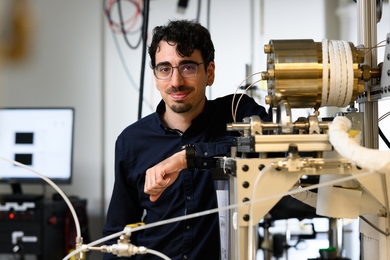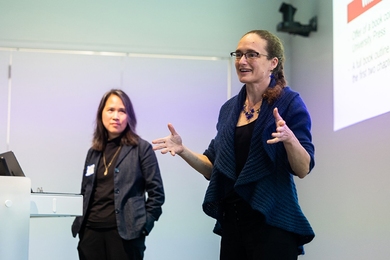At its meeting on November 17, the MIT faculty heard a report on the establishment of a part-time phase-down to retirement now available to faculty members and had a lively discussion about a report and motion of the HASS Overview Committee to implement changes to the HASS-D requirement.
Faculty members also received updates on the Institute's new capital campaign and the Cambridge-MIT Institute, as well as the Community Giving campaign.
CAPITAL CAMPAIGN
President Vest introduced the update on the capital campaign, which was launched November 6 with a daylong MIT event and the dramatic announcement by alumnus and trustee Kenan Sahin (SB 1963) that he was committing $100 million to the campaign.
"We have capital campaigns for two reasons. The first is financial," President Vest said, pointing to a chart that depicted in three contrasting colors, decreasing federal support, roughly level income from tuitions, and (by necessity) rising private support.
"The clear point here is that we have moved from a time in the mid-1960s when about two-thirds of our operating revenue was covered by federal money, to the present state when federal funds cover only about 43 percent of our operating costs. We do not want to look to tuition to make up the difference, so that means, by necessity, that we have to look for more private support from individuals and institutions. I view this not as a problem but as an exciting opportunity from many perspectives," he said.
"Pure finance aside, there is another important motivator. This is a time to gather together the Institute community to discuss how we will realize our many dreams and aspirations. We want to repair and restore our physical campus, renew the environment for student life and learning, and stay at the cutting edge of science and technology. We've got to be able to attract the best students, faculty and administrators," said President Vest.
He recommended for community-wide reading the capital campaign case statement, "a remarkable document affectionately known as 'X and Y' that really captures the special qualities of MIT."
Barbara Stowe, vice president for resource development, portrayed MIT's $1.5 billion capital campaign as both ambitious and promising. A pie chart showed the greater share of individual and alumni/ae giving required to meet MIT's $1.5 billion goal, as compared to "slices" representing other sources such as foundations and corporations.
Not only do gifts by individuals comprise two-thirds of the "pie," she noted, but the hoped-for average amount to be donated by each MIT graduate is a hefty $17,792 -- more than that asked of alumni/ae from any similar institution and about twice as much as Harvard seeks per alumnus or alumna.
The top priorities of the Campaign, whose theme is "Calculated Risks, Creative Revolutions," are new directions for research and education ($550 million); enhancing the learning community ($550 million for undergraduate and graduate financial aid, undergraduate education and student life, and faculty chairs and innovation funds); renewing the physical infrastructure ($300 million) and a $100 million Millenium Fund to support new ideas in research.
Two categories -- undergraduate scholarships and other undergraduate aid, and construction and renovations -- have received more than half of the funds needed to reach their goals.
CAMBRIDGE-MIT INSTITUTE
The University of Cambridge in England and MIT have entered into a major new partnership, known as the Cambridge-MIT Institute, Chancellor Lawrence S. Bacow announced.
The new Institute is an education and research enterprise that has the financial backing of the UK Treasury for 80 percent of its budget for the first five years. The Cambridge-MIT Institute, utilizing faculty and students from the two universities, will develop educational and research programs designed to stimulate the development of new technologies, to encourage entrepreneurship and to improve productivity and competitiveness. Faculty from all five of MIT's schools are expected to participate in some aspect of the program.
Chancellor Bacow has been working on the agreement for more than a year in close association with Daniel Roos, associate dean of engineering and head of the Engineering Systems Division.
"For MIT, this partnership offers an opportunity to participate in the education of the next generation of European technology leaders, to develop important relationships with European industry and to expose its students to the culture of Europe," Chancellor Bacow noted.
THE HASS-D REQUIREMENT
Philip Khoury, dean of the School of Humanities and Social Science, presented the motion to change the humanities, arts and social sciences distribution (HASS-D) requirement. Presently, students must take three subjects from a selection of five distribution categories. One subject must come from categories 1, 2 or 3 (humanities and arts); one subject from categories 4 or 5 (social sciences) and one subject from a remaining category.
Beginning in 2000-2001, students must take three subjects selected from any of the HASS-D categories plus a level III or IV foreign language subject.
Responding to a question about whether the proposed change would alleviate overcrowding in subjects where a lottery is required, Dean Khoury responded that it probably would not, although "the communications requirement may have an impact on how students distribute themselves among courses."
Steven Pinker, professor of brain and cognitive science and director of the Center for Cognitive Neuroscience, spoke about a proposed change in the HASS principles, namely, that HASS offerings complement science and engineering at MIT and also emphasize other methods and modes of discourse.
He acknowledged his personal interest in the fate of the proposal: he teaches 9.00 (Introduction to Psychology), which is the largest course in the social science category and which was targeted as a course that might be excluded from HASS-D under the proposed change.
"In this regard, the proposal has failed in its goal of conveying a clearer picture to students and faculty of the relationship of HASS to the broader MIT curriculum," Professor Pinker said. "I'm one of the people who should benefit from clarity as to the purpose and the status of the proposal, but I don't understand what it means.
"For example, 9.00 is nothing like any course in the sciences. There are no problem sets. There are extensive writing assignments and small-group discussions. The subject matter includes Freud, the self, free will, gender, and the cause of violence and genocide. On the other hand, it is not conducted in an alternative mode of discourse. I couldn't possibly avoid discussion of the sciences, and the course emphasizes empirical testing, logical consistency and compatibility with the sciences. Would it thereby run afoul of the proposed changes?" he asked.
As a "strong supporter of the HASS-D requirement," Professor Pinker expressed concern with the "two cultures view of MIT, with HASS on one side and science and engineering on the other as mutually incomprehensible tribes speaking in different modes of discourse."
He contrasted this with a "conciliatory view in which all knowledge is unified" and he urged that "criteria not be added that ossify a particular view of science vs. HASS as two cultures, nor that are aimed at excluding one particular course."
Dean Khoury reminded those present that the selection of HASS-D criteria has always been the responsibility of the HASS Overview Committee, which comprises faculty from the School of the Humanities and Social Science and the School of Architecture and Planning. President Vest asked Dean Khoury to clarify the committee's intent as to changing or adding HASS-D criteria at the next faculty meeting.
RETIREMENT PLANNING
Professor Steven R. Lerman, chair of the faculty and director of the Center for Educational Computing Initiatives, presented a "part-time phase-down option" to faculty considering retirement.
The proposal would make it easier for individual faculty to phase down their activities in anticipation of retirement and to enable departments to have greater clarity -- for planning purposes -- with regard to when some faculty members may retire. Professor Lerman emphasized that there is no mandatory retirement age and that the new proposal is "yet another path for those who wish to use it."
The proposed policy states: "As a pre-retirement option, during the five years prior to normal retirement age (currently 62), a faculty member may negotiate with his or her department head a mutually acceptable part-time appointment of 50 percent or less. A faculty member who chooses this option and holds a 50 percent time appointment retains all rights during this period, including his or her chair and benefit status."
Professor Lerman also introduced a motion to implement the housekeeping changes to Rules and Regulations (presented at the last meeting), which the faculty voted to accept.
CAMPAIGN LAUNCH
Institute Professor John M. Deutch, co-chairman of the Community Giving campaign, made two points to his colleagues and the MIT community, in order to encourage wider participation in the charitable giving. First, he noted "MIT's poor record in support of community services -- only 1 percent of our colleagues have chosen to participate... the only way this will work is if we care about ourneedy neighbors."
The meeting also included a resolution on the death of Myron Weiner, professor emeritus of political science. Suzanne Berger, professor of political science, read the faculty resolution to record its great sense of loss, and all present stood for a moment of silence to honor Professor Weiner's memory.������
A version of this article appeared in MIT Tech Talk on November 24, 1999.





